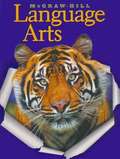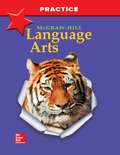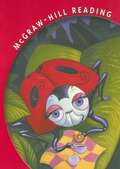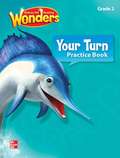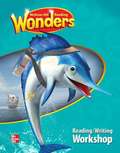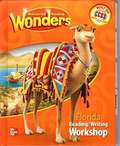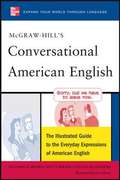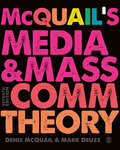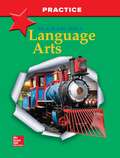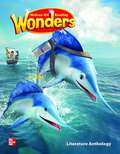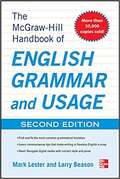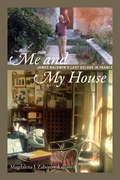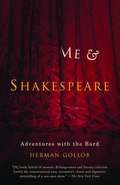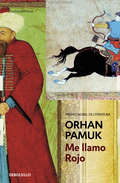- Table View
- List View
McGraw-Hill Language Arts (Grade #2)
by McGraw-HillThe 6 Trait Writing rubric materials in this work use the Six Trait Writing criteria, as defined by the Northwest Regional Educational Laboratory.
McGraw-Hill Language Arts (North Carolina Edition)
by McGraw-HillThe contents of the text are: Sentences and Personal Narrative, Nouns and Persuasive Writing, Verbs and Explanatory Writing, Adjectives and Expository Writing, Pronouns and Writing that Compares, Pronouns and Writing that Compares, etc.
McGraw-Hill Reading
by Barbara Coulter Frankie Dungan Joseph B. Rubin Shirley WrightA collection of stories with test questions at the end of each story.
McGraw-Hill Reading (Grade 3, Book #1)
by Angela Shelf Medearis Jan E. Hasbrouck James Flood Diane Lapp Josefina Villamil Tinajero Donna Lubcker Karen D. Wood James V. Hoffman Scott Paris Steven StahlReading textbook for 3rd graders.
McGraw-Hill Reading 1st Grade Book 5
by Macmillan Mcgraw-HillA textbook designed to help children improve their literature skills through the use of poems, interesting comprehension passages and test questions.
McGraw-Hill Reading Book 1
by Angela Shelf Medearis Jan E. Hasbrouck James Flood Diane Lapp Josefina Villamil Tinajero Karen D. Wood James V. Hoffman Scott Paris Steven StahlThis book is a treasure of vast reading materials packed under the heads of What's New, Just Between us and Express yourself with plenty of illustrations.
McGraw-Hill Reading Wonder Works Grade 3
by Douglas Fisher Timothy Shanahan Jan HasbrouckLanguage Arts Textbook for Grade 3
McGraw-Hill Reading Wonders Grade 2 Your Turn Practice Book
by The Editors at the The McGraw-Hill CompaniesWorkbook 2nd Grade
McGraw-Hill Reading Wonders Reading/Writing Workshop, Grade 2
by The Editors at McGraw Hill EducationMcgraw-hill Reading Wonders Reading/Writing Workshop, Grade 2.
McGraw-Hill Reading Wonders: Florida Reading Writing Workshop, Grade 3
by McGraw-Hill Education<P>"With your Florida Reading/Writing Workshop you will: <br>Talk About New Ideas; <br>Read and Reread Exciting Literature; <br>Read and Reread Informational Text; <br>Look for Text Evidence; <br>Access Complex Text; <br>Be an Expert Writer; and <br>Do Your Own Research."
McGraw-Hill's Conversational American English: The Illustrated Guide to the Everyday Expressions of American English
by Betty J. Birner Richard A. Spears Steven Racek Kleinedler Luc NissetAs a new speaker of English, you may hear some expressions in your daily conversations that you do not understand--yet. McGraw-Hill's Conversational American English will help you learn these expressions, so not only do you know what a person is saying to you, but that you can use the expression yourself! More than 3,000 expressions are organized by theme, so you can find what you are looking for quickly. And each topic is illustrated to further help you understand context. The book features: Common expressions are batched into 350 themes, ranging from general greetings and asking how someone is, to the more specific needs, like showing disbelief, asking someone's intentions, and expressions for a forgotten word or name A comprehensive thematic glossary provides an additional means for the learner to locate expressions by key words and concepts Topics include: Basic Social Encounters, Greetings, Small Talk, Introductions, Ending a Conversation, Good-Byes, Agreeing, Disagreeing Conversational Encounters, Focusing Attention, Launching the Conversation, Making Friends, Complex Matters, Disputes, Discussion and Resolution, Polite Encounters, Prefaces, Communication Barriers
McQuail’s Media and Mass Communication Theory
by Mark Deuze Professor Denis McQuailNow in its seventh edition, this landmark text continues to define the field of media and mass communication research, offering a uniquely detailed, broad, and balanced guide. It maintains the narrative into the world of pervasive, ubiquitous, mobile, social and always-online media that we live in today. New to this edition: • Examples are now integrated within each chapter around politics and the public sphere, as popular culture and politics become more regularly intertwined. • An increased focus on conceptualizing &‘mass&’ media and communication and media theory in an age of big data, such as algorithmic culture, AI, platform economies, streaming, and mass self-communication. • Further discussion of what we want and expect of media and society in all chapters. • New and revised material, including a new chapter &“A Canon of Media Effects&”, bringing together Social-Cultural Effects & News, Public Opinion and Political Communication, helping the reader to rethink and reframe the whole idea of media effects and influence. A vitally important for all students of Media and Mass Communication in the 21st century.
McQuail’s Media and Mass Communication Theory
by Mark Deuze Professor Denis McQuailNow in its seventh edition, this landmark text continues to define the field of media and mass communication research, offering a uniquely detailed, broad, and balanced guide. It maintains the narrative into the world of pervasive, ubiquitous, mobile, social and always-online media that we live in today. New to this edition: • Examples are now integrated within each chapter around politics and the public sphere, as popular culture and politics become more regularly intertwined. • An increased focus on conceptualizing &‘mass&’ media and communication and media theory in an age of big data, such as algorithmic culture, AI, platform economies, streaming, and mass self-communication. • Further discussion of what we want and expect of media and society in all chapters. • New and revised material, including a new chapter &“A Canon of Media Effects&”, bringing together Social-Cultural Effects & News, Public Opinion and Political Communication, helping the reader to rethink and reframe the whole idea of media effects and influence. A vitally important for all students of Media and Mass Communication in the 21st century.
Mcdougal Littell Literature and Language, Orange Level (Grade #9)
by James Marshall Arthur N. Applebee Judith A. Langer Andrea B. BerrnúdezThis book is unlike any textbook you have ever used. It is based on a unique philosophy--that what you bring to this book is just as important as what the book brings to you. This means that your own experiences become the basis for your involvement with the literature and activities. The special features in Literature and Language promote this relationship between you and the text.
Mcdougal Littell Literature and Language: Ninth-Grade, Orange Level
by Jane N. BeattyAn anthology of fiction, non-fiction, poetry, drama, etc. The selections in this book represent some of the finest examples of unadapted traditional and contemporary literature. There are classics that have been read and enjoyed again and again, as well as exciting pieces that have never before appeared in a literature textbook. What you read will challenge your ways of thinking, illustrate the cultural and ethnic variety of your world, and relate to experiences in your own life.
Mcdougal Littell Literature: British Literature (Pennsylvania Edition)
by Mcdougal LittellLiterature textbook, focusing on British literature, for Pennsylvania students.
Mcdougal Littell Literature: The Interactive Reader Plus
by Mcdougal LittellThe InterActive Reader Plus is a new kind of literature book. As you will see, this book helps you become an active reader. It is a book to mark on, to write in, and to make your own. You can use it in class and take it home.
Mcgraw-Hill Language Arts (Grade #3)
by McGraw-HillPractice pages provide exercises to accompany lessons presented in McGRAW-HILL LANGUAGE ARTS. At-home activities are provided on every page. Practice pages can be used as students work through the unit.
Mcgraw-Hill Reading Wonders Grade 2 CCSS Reading/Language Arts
by Donald R. Bear Janice A. Dole Diane August Jana Echevarría [et al.]Literature textbook
Mcgraw-hill Handbook Of English Grammar And Usage
by Mark Lester Larry BeasonReviews the rules of English grammar, covering such topics as verb forms, subject-verb agreement, punctuation, capitalization, parallelism, who versus whom, and etiquette for digital communication.
Me and My House: James Baldwin's Last Decade in France
by Magdalena J. ZaborowskaThe last sixteen years of James Baldwin's life (1971–87) unfolded in a village in the South of France, in a sprawling house nicknamed “Chez Baldwin.” In Me and My House Magdalena J. Zaborowska employs Baldwin’s home space as a lens through which to expand his biography and explore the politics and poetics of blackness, queerness, and domesticity in his complex and underappreciated later works. Zaborowska shows how the themes of dwelling and black queer male sexuality in The Welcome Table, Just above My Head, and If Beale Street Could Talk directly stem from Chez Baldwin's influence on the writer. The house was partially torn down in 2014. Accessible, heavily illustrated, and drawing on interviews with Baldwin's friends and lovers, unpublished letters, and manuscripts, Me and My House offers new insights into Baldwin's life, writing, and relationships, making it essential reading for all students, scholars, and fans of Baldwin.
Me and Shakespeare: Adventures with the Bard
by Herman GollobIn this unique memoir, a legendary editor tells how, on the verge of retirement, he developed a passion for the works of Shakespeare and gained new perspectives on his own life.
Me llamo rojo
by Orhan PamukEn el Estambul de finales del siglo XVI, el Sultán encarga secretamente un gran libro que celebre su vida y su imperio. Los encargados de iluminar esa obra son los mejores artistas del momento, pero... deberán hacerlo al modo europeo. Cuando uno de esos miniaturistas desaparece y nacen las sospechas de asesinato, el maestro del taller deberá buscar ayuda.

